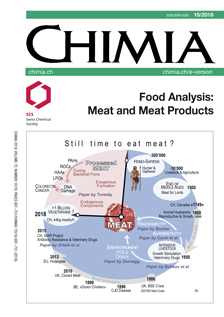Mechanistic Evidence for Red Meat and Processed Meat Intake and Cancer Risk: A Follow-up on the International Agency for Research on Cancer Evaluation of 2015
DOI:
https://doi.org/10.2533/chimia.2018.718PMID:
30376922Keywords:
Colorectal cancer, Dna damage, GenotoxicantAbstract
The Working Group of the International Agency for Research on Cancer classified the consumption of processed meat as carcinogenic to humans (Group 1), and classified red meat as probably carcinogenic to humans (Group 2A); consumption of both meat types is associated with an increased risk of colorectal cancer. These classifications are based on a compilation of epidemiology data and mechanistic evidence from animal and human studies. The curing of meats with nitrite can produce carcinogenic N-nitroso compounds (NOCs), and the smoking of meat produces polycyclic aromatic hydrocarbons (PAHs). The high-temperature cooking of meat also produces carcinogenic heterocyclic aromatic amines (HAAs). The ingestion of heme from meat can catalyze the formation of NOCs and lipid peroxidation products (LPOs) in the digestive tract. Many of these chemicals form DNA adducts, some of which can induce mutations and initiate carcinogenesis. Another recent hypothesis is that N-glycolylneuraminic acid, a non-human sialic acid sugar present in red meat, becomes incorporated in the cell membrane, triggering the immune response with associated inflammation and reactive oxygen species, which can contribute to DNA damage, tumor promotion, and cancer. The mechanisms by which these chemicals in meat induce DNA damage, and the impact of dietary and host factors that influence the biological potency of these chemicals are highlighted in this updated report.Downloads
Published
2018-10-31
Issue
Section
Scientific Articles
License
Copyright (c) 2018 Swiss Chemical Society

This work is licensed under a Creative Commons Attribution-NonCommercial 4.0 International License.
How to Cite
[1]
Chimia 2018, 72, 718, DOI: 10.2533/chimia.2018.718.







